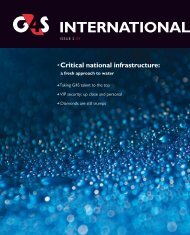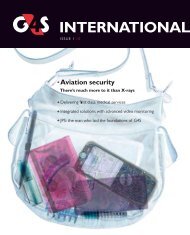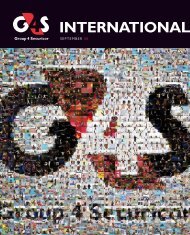G4S Annual Report and Accounts 2011
G4S Annual Report and Accounts 2011
G4S Annual Report and Accounts 2011
Create successful ePaper yourself
Turn your PDF publications into a flip-book with our unique Google optimized e-Paper software.
Overview Strategic review Performance<br />
Notes to the consolidated financial statements continued<br />
3 Significant accounting policies continued<br />
(e) Intangible assets continued<br />
Acquisition-related intangible assets<br />
Intangible assets on acquisitions that are either separable or arising from contractual rights are recognised at fair value at the date of acquisition. Such<br />
acquisition-related intangible assets include trademarks, technology, customer contracts <strong>and</strong> customer relationships. The fair value of acquisition-related<br />
intangible assets is determined by reference to market prices of similar assets, where such information is available, or by the use of appropriate valuation<br />
techniques, including the royalty relief method <strong>and</strong> the excess earnings method.<br />
Acquisition-related intangible assets are amortised by equal annual instalments over their expected economic life. The directors review acquisition-related<br />
intangible assets on an ongoing basis <strong>and</strong>, where appropriate, provide for any impairment in value.<br />
The estimated useful lives are as follows:<br />
Trademarks<br />
up to a maximum of five years<br />
Customer contracts <strong>and</strong> customer relationships<br />
up to a maximum of ten years<br />
Technology<br />
up to a maximum of five years<br />
Other intangible assets – development expenditure<br />
Development expenditure represents expenditure incurred in establishing new services <strong>and</strong> products of the group. Such expenditure is recognised as an<br />
intangible asset only if the following can be demonstrated: the expenditure creates an identifiable asset, its cost can be measured reliably, it is probable that<br />
it will generate future economic benefits, it is technically <strong>and</strong> commercially feasible <strong>and</strong> the group has sufficient resources to complete development. In all<br />
other instances, the cost of such expenditure is taken directly to the income statement.<br />
Capitalised development expenditure is amortised over the period during which the expenditure is expected to be revenue-producing, up to a<br />
maximum of ten years. The directors review the capitalised development expenditure on an ongoing basis <strong>and</strong>, where appropriate, provide for any<br />
impairment in value.<br />
Research expenditure is written off in the year in which it is incurred.<br />
Other intangible assets – software<br />
Computer software is capitalised as an intangible asset if such expenditure (both internally generated <strong>and</strong> externally purchased) creates an identifiable<br />
asset, if its cost can be measured reliably <strong>and</strong> if it is probable that it will generate future economic benefits. Capitalised computer software is stated at cost,<br />
net of amortisation <strong>and</strong> any provision for impairment. Amortisation is charged on software so as to write off the cost of the assets to their estimated<br />
residual values by equal annual instalments over their expected useful economic lives up to a maximum of five years.<br />
(f) Property, plant <strong>and</strong> equipment<br />
Property, plant <strong>and</strong> equipment is stated at cost, net of accumulated depreciation <strong>and</strong> any provision for impairment. Depreciation is provided on all property,<br />
plant <strong>and</strong> equipment other than freehold l<strong>and</strong>. Depreciation is calculated so as to write off the cost of the assets to their estimated residual values by equal<br />
annual instalments over their expected useful economic lives as follows:<br />
Freehold <strong>and</strong> long leasehold buildings<br />
up to 50 years<br />
Short leasehold buildings (under 50 years)<br />
over the life of the lease<br />
Equipment <strong>and</strong> motor vehicles<br />
2 to 10 years<br />
Assets held under finance leases are depreciated over their expected useful economic lives on the same basis as owned assets or, where shorter, over the<br />
term of the relevant lease.<br />
Where significant, the residual values <strong>and</strong> the useful economic lives of property, plant <strong>and</strong> equipment are re-assessed annually. The directors review the<br />
carrying value of property, plant <strong>and</strong> equipment on an ongoing basis <strong>and</strong>, where appropriate, provide for any impairment in value.<br />
(g) Financial instruments<br />
Financial assets <strong>and</strong> financial liabilities are recognised when the group becomes a party to the contractual provisions of the instruments.<br />
Trade receivables<br />
Trade receivables do not carry interest <strong>and</strong> are stated initially at their fair value. The carrying amount of trade receivables is reduced through the use of a<br />
bad debt allowance account. The group provides for bad debts based upon an analysis of those that are past due in accordance with local conditions <strong>and</strong><br />
past default experience.<br />
Service concession assets<br />
Under the terms of a Private Finance Initiative (PFI) or similar project the risks <strong>and</strong> rewards of ownership of an asset remain largely with the purchaser of<br />
the associated services. In such cases, the group’s interest in the asset is classified as a financial asset <strong>and</strong> included at its discounted value within trade <strong>and</strong><br />
other receivables, to the extent to which the group has an unconditional right to receive cash from the grantor of the concession for the construction of the<br />
asset. To the extent that the group has the right to charge for the use of such an asset, conditional upon the extent of the use, the group recognises an<br />
intangible asset.<br />
Current asset investments<br />
Current asset investments comprise investments in securities, which are classified as held-for-trading. They are initially recognised at cost, including<br />
transaction costs, <strong>and</strong> subsequently measured at fair value. Gains <strong>and</strong> losses arising from changes in fair value are recognised in the income statement.<br />
Cash <strong>and</strong> cash equivalents<br />
Cash <strong>and</strong> cash equivalents comprise cash balances <strong>and</strong> call deposits. Bank overdrafts that are repayable on dem<strong>and</strong> <strong>and</strong> form an integral part of the group’s<br />
cash management are included as a component of cash <strong>and</strong> cash equivalents for the purpose of the cash flow statement.<br />
80<br />
<strong>G4S</strong> plc<br />
<strong>Annual</strong> <strong>Report</strong> <strong>and</strong> <strong>Accounts</strong> <strong>2011</strong>











